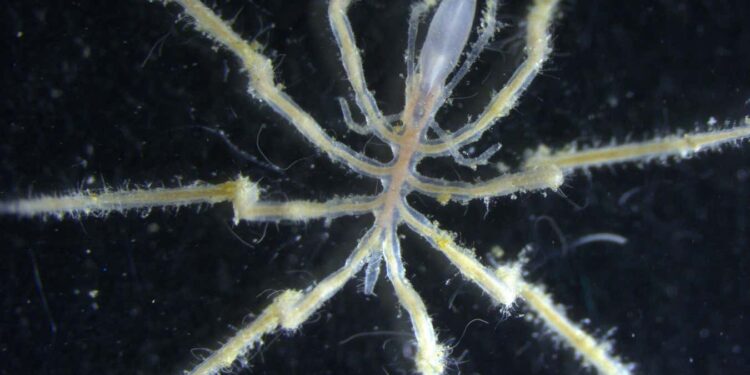
Sea spider from the genus Sericosura
Biance Dal Bó
Spider-like creatures living near methane seeps on the seafloor appear to cultivate and consume microbial species on their bodies that feed on the energy-rich gas. This expands the set of organisms known to rely on symbiotic relationships with microbes to live in these otherworldly environments.
Shana Goffredi at Occidental College in California and her colleagues collected sea spiders – marine arthropods named for their resemblance to arachnids – living near three different methane seeps in the Pacific Ocean. They found three previously unknown species from the sea spider genus Sericosura that appear to be abundant only near these gas seeps.
Other types of sea spiders that don’t live near seeps largely eat other invertebrates. But the researchers found the new sea spiders appear to get most of their nutrition by eating a distinctive set of bacterial species that live on their bodies. These bacteria harvest energy by metabolising methane and methanol coming from the seeps, energy that would otherwise be inaccessible to the sea spiders.
The researchers found the bacteria were confined to the spiders’ exoskeletons like a “microbial fur coat”, growing in what Goffredi describes as “volcano-like” clusters. The layers of bacterial growth also had markings like lawnmower tracks where the spiders may have munched on them using their hard “lips” and three tiny teeth.
To confirm the sea spiders really were eating the bacteria, the researchers also used a radioactive labelling technique to track how the carbon in methane was consumed by the sea spiders in the lab. “We watched that methane go into the microbes that are on the surface of the spiders, and then we watched that carbon molecule move into the tissues of the spider,” says Goffredi.
The researchers don’t think the sea spiders are just eating whatever happens to grow on their exoskeletons. Because the species that live on the exoskeletons are distinct from what’s generally found in the environment, it suggests some kind of selection process is at play, says Goffredi. “The spiders are definitely cultivating and farming a very special type of community.”
Sea spiders wouldn’t be the first organisms to farm microbes to access chemical energy. “Each time we look [at ecosystems around methane seeps], we’re finding this more and more,” says Erik Cordes at Temple University in Pennsylvania. He worked with Goffredi on an earlier project that found a similar symbiosis in tube worms. The abundance of life found near the seeps “is being fuelled by methane and other chemicals and not by the energy of the sun. That’s pretty amazing,” he says.
Cordes points out that the bacteria also stand to gain by riding along on the sea spiders’ bodies. Not unlike cows on a ranch, they gain protection and access to better pastures. For instance, if a methane seep shifts to a different part of the seafloor, the sea spiders could move the bacteria to the new source. “The sea spiders are keeping them in the perfect habitat,” he says.
Topics:
Source link : https://www.newscientist.com/article/2485354-sea-spiders-farm-methane-eating-bacteria-on-their-bodies/?utm_campaign=RSS%7CNSNS&utm_source=NSNS&utm_medium=RSS&utm_content=home
Author :
Publish date : 2025-06-20 21:02:00
Copyright for syndicated content belongs to the linked Source.














